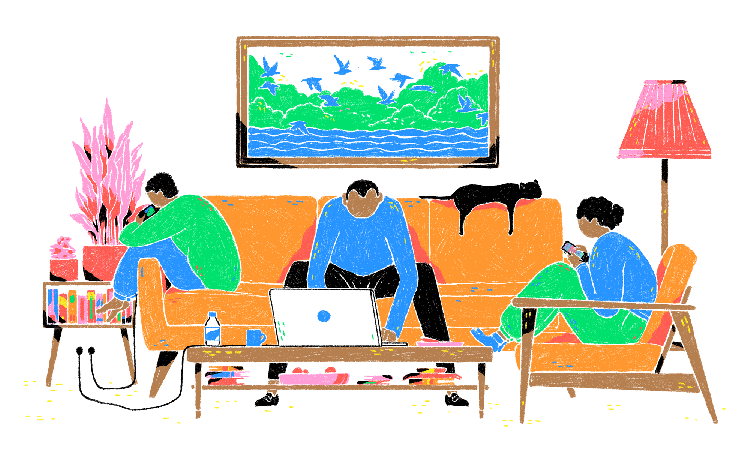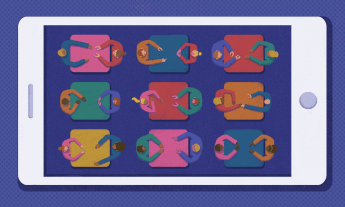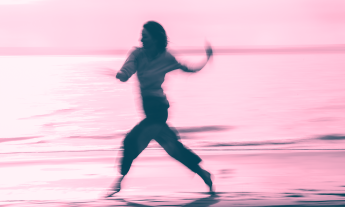
This post is part of TED’s “How to Be a Better Human” series, each of which contains a piece of helpful advice from people in the TED community; browse through all the posts here.
One of the side effects of working from home full-time because of the pandemic is working with a less than ergonomically ideal setup. Most of us didn’t have a home office space ready and waiting when we began to shelter in place, so if you’ve spent the past two months shifting around on a borrowed dining room chair with a cushion wedged behind you, you’re not alone.
But no matter our seating arrangements, there are some important things we can do to care for our backs, says Esther Gokhale, posture expert, acupuncturist and creator of the Gokhale Method. It doesn’t mean buying an expensive chair, either. “You don’t need anything fancy if you know what you’re doing to your own body,” she explains.
First of all, the problem isn’t with sitting itself, but how we’re doing it, says Gokhale. “It’s a cute soundbite to say ‘sitting is the new smoking’, but it’s very inaccurate to blame sitting. But no one in modern Western society is doing very well by their spinal discs, or vertebrae, or muscles or nerves.“
So what are we doing wrong?
It actually starts with something we were all taught — incorrectly, as it turns out — starting in childhood: sit up straight, shoulders back.
This advice, says Gokhale, sets us up in the wrong position. “What we end up doing is arching our backs by tensing up our muscles — the ropey ones that the massage therapist will tell you are tight. When we tighten them, we shorten them, and that arches the back, and what that does is it loads the discs [in the lower back] and jams the edges of the vertebrae against each other.”
When we keep trying to sit up straight, we can ultimately alter our anatomy, she explains. “If that becomes a habit — which it does for many people — then those tight, short muscles inhibit the blood supply in the area so now you have an anemic back and repair isn’t happening efficiently.”
This effort also takes an enormous amount of energy and it doesn’t actually last; we’re likely to slump again after a few minutes when we get tired.
If you have a tendency to slump — and most of us do — then you need to learn to lengthen your back. “You could [periodically] stop work to stretch your muscles for a few minutes and they’d get some relief, but a much smarter way is to use the time that you’re sitting to stretch yourself against the backrest,” explains Gohkale. She has created a technique called “stretch sitting” to help perfect this motion. The key? Don’t tuck in your tailbone, and use your muscles more.
As she describes in her TEDx Talk (and you can see her demonstrate this by clicking here):
“You are going to sit with your bottom well back in your chair, and then hinge away from the back rest. Place your fists on the lower border of your rib cage, and then gently push back so as to elongate your lower back. And now, grab some place of your chair maybe your arm rests or any other part of your chair, and gently push the top of you away form the bottom of you, like this; and now, hitch yourself to the back rest.
OK, now, ideally the chair would have some grippy thing mid-back to hold you, like you see here or you would have an implement like our stretch sit cushion or a folded towel — something with friction to meet your mid-back and actually hold you up. Since you don’t have any implement, you might try bunching up your fabric in the back of your clothing, creating a kind of ledge, then hooking yourself there, and totally relaxing.”
To have a healthier back, developing core strength is important — but avoid doing crunches. Gokhale believes that you should focus on what she calls the “inner corset”; the group of core muscles that support your spine. The problem, she says, is that people tend to focus on one muscle when developing core strength — the rectus abdominus — but this won’t support our spines.
In fact, the exercises we do to strengthen our back often end up hurting us. “Crunches are well named; they crunch your discs and they crunch your nerves,” says Gokhale. “Instead, you should engage particular muscles that are deep in the abdomen and back. Then, when you’re going to do something active, instead of letting your discs and your nerves take the brunt, you let your muscles do the job.” (Gohkale offers a free guide to caring for your inner corset on her website.)
Standing desks can be good, but it’s still about how you hold your body. When you stand, Gokhale recommends adopting a stance of “readiness”, maintaining a little bit of spring in your knees. “The average person stands parked in their joints, locking their knees back, locking the hips forward, and arching their back,” she explains. “However, the groin is where most of the circulation to and from the legs happens, so you’re blocking all of that. Then, you’re creating an extra curve [in the spine] but you’re distending the ligaments and damaging the discs.”
Here’s the adjustment you need to make. “So what I teach people is to have a little bit of a ready position, with a little spring,” says Gokhale. “That takes muscular effort, but it’s way sounder. If your muscles aren’t used to working this little bit, then the chair pose [in yoga] is something that I recommend as a way of strengthening the same muscles that you need for standing well. In general: Use your muscles, spare your joints.”
When you’re relaxing on the sofa, it’s important to think about your back. We don’t stop damaging — or taking care of — our backs when our working day ends; everything we do has an impact on our bodies. So we should consider stretch sitting while we’re on the sofa too, suggests Gokhale.
This doesn’t mean that you need to tense up there, or that you can’t have a nice, deep sofa to sink into. But you should add a few cushions if you feel you need more support. “The key thing is you want to be upright and relaxed, not upright and tense and not relaxed and slumped. The way you put your base — your pelvis — is key.” This means not tucking in our tailbones, as we often tend to do when we relax on the sofa.
How you sleep affects your back too. Unfortunately, Gokhale has bad news for front sleepers: Don’t. “When you lie down on your front, you have a tendency to arch your back, and your neck is being asked to turn 90 degrees, which it isn’t able to very well. So there’s a lot of squishing and squashing. It’s not good.” Instead, try sleeping on your side — with a pillow between your knees to balance your hips if you suffer from back pain — or on your back.
The good news, says Gokhale, is you don’t need a fancy mattress. “The most important thing to do is add length to your body. Whatever length you have when you plop yourself down onto the bed is the length you’re going to have for the rest of the night. If it’s your short, compressed, daytime, arched or slumped length, then that’s what you’re doing in your bed.”
She recommends stretching out a little bit when you first lie down, focusing on lengthening your back rather than stretching your front so that you don’t arch your spine. That way, you can relax and have a night of sleep that’s good for you and your back.
Watch her TEDxStanford talk here:














